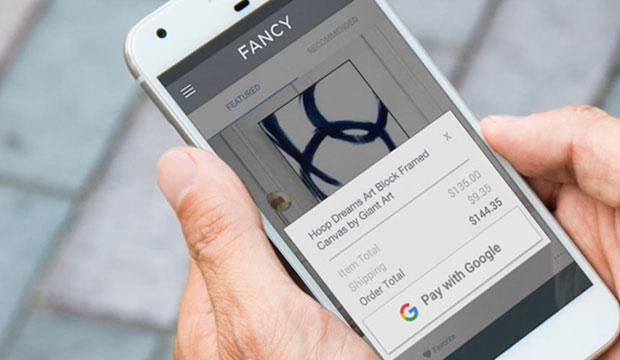Google on Monday rolled out an online payment service that’s designed to accelerate the online checkout process.
While the new offering isn’t quite Amazon One-Click, it will eliminate many of the annoying steps that can slow down the online purchase process and often result in abandoned shopping carts.
Pay with Google uses address and credit or debit card information users provide to Google to speed them through checkout. Instead of a merchant collecting that information from the customer, it’s sent behind the scenes by Google.
Google has called on website and app developers to incorporate Pay with Google into their creations.
“You can implement it with just a few lines of code, and it’s free — we don’t charge any transaction fees,” said Pali Bhat, Google’s vice president for payments products.
Google understands that it takes more than an application programming interface and a service to create a critical mass of users, said Rajiv Dholakia, vice president for products and business development at Nok Nok Labs.
“Pay with Google is doing that by bringing Google’s users as well as its developers to the party,” he told the E-Commerce Times.
Convenient Service
For anyone with a Google account, the payment service can be very convenient.
“Customers can direct payments from any of the credit cards they have registered with Google companies, including Chrome, Android Pay, YouTube and Google Play,” noted Charles King, principal analyst at Pund-IT.
“Plus, they don’t have to fill in numbers or address lines, thus speeding up the payment process,” he told the E-Commerce Times.
Users upgrading their Android phones also will find Pay with Google a cozy fit.
“They don’t have to add new cards every time they get a new phone. They can leverage their cards from Google,” said Patrick Moorhead, principal analyst at Moor Insights and Strategy.
On the downside, that does create one-stop-shopping for cybercriminals, since a shopper’s credit cards are stored at a single location.
“I see that as a low probability, though, as Google is typically secure,” Moorhead told the E-Commerce Times.
“Since [Pay with Google] is based on the Android Pay platform, it supports those same security features and functions,” said Pund-IT’s King.
Google’s Gain Is Merchants’ Loss
Performing online transactions using Pay with Google is especially secure when compared to data protection methods found at many merchants.
“Your credentials are pretty darn safe behind Google’s firewalls,” said David Robertson, publisher of The Nilson Report.
“The reality is too many merchants store our data on systems that can be compromised,” he told the E-Commerce Times.
“Merchants have never historically been in the business of protecting information,” Robertson continued, “and many CEOs don’t understand what’s needed to be spent to protect data stored about their customers.”
However, there’s a significant drawback for merchants to funneling transactions through Google.
“Google is separating the merchant from the opportunity to collect information about their customers,” Robertson said.
Youthful Tilt
At launch, Pay with Google had 15 partners, with another 12 in the wings and the expectation of many more as the service picks up momentum.
Still, the offering may not attract as broad an audience as Google would like it to.
“Customers need to have bought into Google as a primary mobile and service provider,” Pund-IT’s King explained.
“Plus, the retail partners are tilted to companies focusing on younger consumers,” he added. “That’s likely to change over time, but it could limit interest among older customers.”
What’s more, if Google is betting on more people paying for things with their phones to boost Pay with Google usage, it may be disappointed.
“I believe the value proposition for mobile payments remains fairly weak,” King said. “The function it proposes to eliminate — using a physical credit card — is hardly onerous, and most consumers continue to have concerns about the security and trustworthiness of mobile payments.”
Nevertheless, Google had to get into the payment aggregator game with a product like Pay with Google, maintained Nilson’s Robertson.
“No one knows what the landscape is going to look like three years from now, but everybody is trying to get their ducks lined up to play in as many ponds as possible,” he explained. “So if you have the capability to be a payment aggregator, it seems to be a good play.”
























































Social Media
See all Social Media